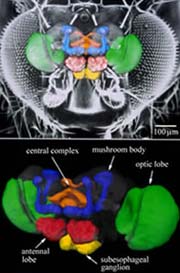

Average insect brain should help spot defects and their causes.
Two hair’s breadths long and five across – that’s the average capacity of a fly’s brain, German researchers have calculated. They hope to set a benchmark for crania by which oddballs can be judged.
Although it is a creature of little brain, the fruit fly (Drosophila) is popular with geneticists. Researchers often study flies that lack a particular gene, looking for flaws that might hint at the gene’s function in the body.
But you can’t spot a faulty brain until you have a reference. So Martin Heisenberg, of the University of Wurzburg in Germany, and his colleagues have measured up a fly ’standard’ brain1.
Drosophila crania are pretty uniform, they found – with no obvious masterminds or dunces. The team dissected 120 brains and sized them up using a three-dimensional microscope. Using specially designed software, they aligned the images and drew up average dimensions.
“It’s a good idea,” says Nicholas Strausfeld of the University of Arizona, who runs the web atlas Flybrain. Knowing the average shape and size means that flies with subtle brain defects can be picked out. In future, thousands of insects with genetic mutations could be screened. Learning and memory are particularly hot topics, in which such comparisons could prove useful, says Strausfeld.
Different strain’s brains reflect their lifestyles, the team has already found. One line, bred in jars, proves the ’use it or lose it’ adage. Years of cramped conditions has shrunk the brain region that controls flight and expanded the one that governs walking. And with a carefully controlled sex life, the lobe that sniffs out mates has also fallen into decline.
Heisenberg hopes that fly researchers will adopt his ’standard’ brain to collate information on gene activity. Around two-thirds of a fly’s genes operate in the brain – each one at a different time and place. If mapped onto a template, these could be compiled into a central database that would enable labs to compare their results. “He’s got to persuade the community,” points out Strausfeld, before the standard can be adopted.
Model human
Efforts to gauge the average human brain are taking a similar tack, says John Mazziotta of the University of California, Los Angeles, who heads the International Consortium for Brain Mapping.
Using magnetic-resonance imaging (MRI) pictures collected from nearly 7,000 people, the team hopes to define a human reference brain. This could be compared to patients with Alzheimer’s disease or stroke to pinpoint brain regions that are affected. The human standard is set to be completed by September 2003.
“We’d like to have such a reference brain,” says Robert Brandt of the Free University of Berlin, who is compiling an equivalent for bees.
References
- Rein, K. The Drosophila Standard Brain. Current Biology, 12, 227 – 231, (2002).














